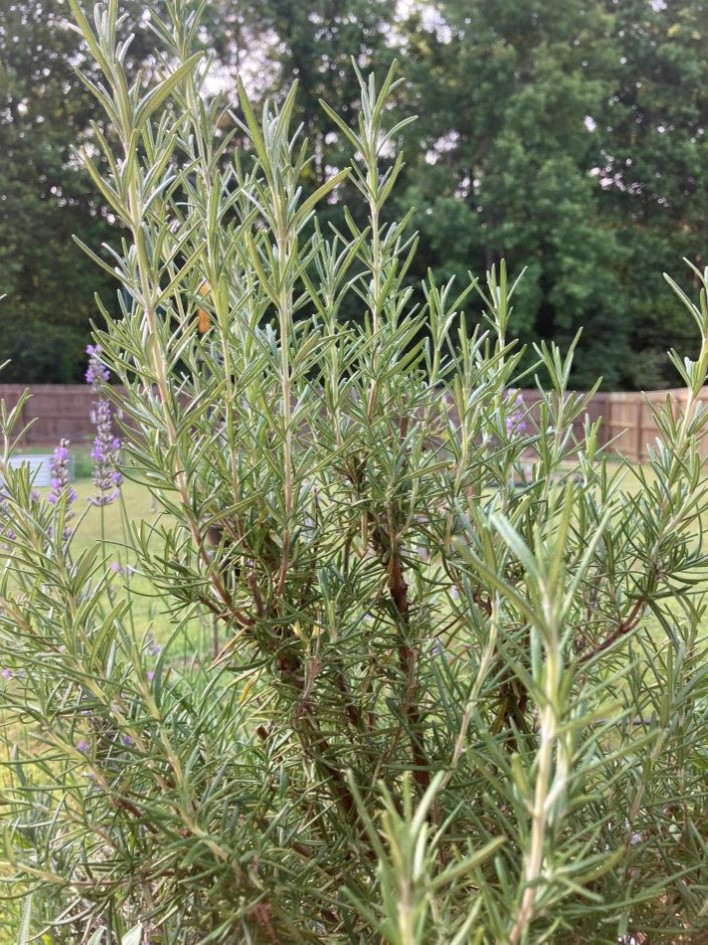
Rosemary
An aromatic herb, rosemary flavors a variety of meats, chicken, and potatoes.
|
N/A |
|
Salvia rosmarinus |
|
Intermediate to Easy |
|
Easy to Intermediate |
|
1-4 years if properly stored |
|
Perennial in zones 7-10 |
|
14-28 days |
|
None |
|
Surface Sow |
|
2-3+ feet |
|
Needs light to germinate Full sun to part shade |
|
December and January Special Seed Library Event |
|
Yes |

Rosemary Picture by Elizabeth Jones
Growing Tips


When to Start
Winter: Start indoors 3-6 MONTHS before the last frost. (Around Christmas is a good time to start for Jefferson, GA)
Transplant: After the danger of frost has passed. (May 1 for Jefferson, GA)
How to Grow
Rosemary is a very slow grower. To have it ready for transplant after the danger of frost has passed, it should be started in early winter: 3-6 MONTHS before the last frost. (I start mine around Christmas for a May 1 transplant.)
Rosemary needs light to germinate. Gently press the seeds into the seed starting mix. Sow thickly as germination can be spotty. Then place the cells under grow lights. Keep the soil moist but not soggy. Once plants have at least 3-4 true leaves, thin to one plant per cell. Some recommend placing the cells on a heat mat, as rosemary likes to germinate with soil temperatures around 80F. Pot them up when the seedlings are the same height as the depth of the cell. Continue to pot them up as needed.
Care
Transplant after hardening off and the danger of frost has passed. (May 1 for Jefferson, GA.) Rosemary needs full sun, but can benefit from afternoon shade during hot summers. Well-draining soil is important as it detests wet feet. Rosemary does well in a container or in the ground.
It is relatively pest free and drought-tolerant. It may get a fungus if it is too humid or if it is over-watered (wet feet). Let it dry out between watering to help prevent this as it doesn’t like overly moist soil. When planting in a pot, water so that the water drains out the bottom of the pot. This will help keep salt and other minerals from fertilizer from building up in the soil and making the soil toxic. This is a good practice for any potted plant.
Rosemary is a perennial in zones 7-10. In areas where the winter is harsher, plant in a pot and bring it inside during the winter. Or treat it as an annual. Rosemary is a small shrub and will get woody. This can give it an unsightly appearance. It can be replaced every 2-3 years once the plant gets mature and woody or it can be transplanted in the ground and treated as a bush in warmer zones. It will typically bloom in the second year.
Interesting Fact
Rosemary is a natural tick repellant. If you plant it in the ground, don’t be surprised if deer roll in it. They are trying to get the oils from the herb onto their skin.
Harvest
Rosemary can be harvested all year, but new growth has the best flavor. Harvest little and often to encourage more growth. Cut young sprigs in the morning for peak flavor. To store, place unwashed sprigs in a container and place them in the refrigerator.
The woody parts of the rosemary will not produce more branches once cut. Only harvest the new growth. For a pleasing shape, harvest or prune the plant to look like a Christmas tree.
Pruning
In late winter just before new growth starts, prune back the plant. Remove any winter-damaged branches or stems. Cut to the nearest healthy portion of the stem and don’t prune any woody branches.
In late spring or early summer, prune the plant by 1/3 to help control the size and shape. This is especially beneficial for potted plants. DO NOT cut into the woody parts of the branch as rosemary doesn’t grow back well from the woody portions.
Drying Leaves
Drying is a good way to preserve rosemary for use all year long! Harvest in the morning for peak flavor. Wash. Tie sprigs together and hang them upside down. Rosemary has lots of oils in it and can take a few weeks to dry. Once dry, remove leaves and store whole in airtight containers. Leaves can be crushed or ground before use.
How to use
Rosemary is a very flavorful aromatic. It is a very versatile herb that can be used in a wide array of dishes. It is good in bread, roasted and smoked meats, vegetables like potatoes, and even drinks. It can be made into lemonade and tea. Traditionally, rosemary tea was used to treat migraines, help clear stuffy heads, and relax tension. When used as a tea it might need a sweetener or be mixed with black tea and/or other herbs as it is very pungent. It can also be used in potpourri.
To make tea: Add 1 teaspoon of fresh or dried leaves to 1 cup of boiling water. Steep and strain the leaves. I like to steep my rosemary with a black tea bag and add a splash of milk rather than drink plain rosemary water. As long as no more than 1 teaspoon of leaves has been used, I haven’t found the flavor too pungent.
Pro Tip!
Incompatibles: Cucumber
Grows well with: All brassicas (kale, broccoli, etc.), beans, carrots, and sage
My personal experience
Starting from Seed
I start mine around Christmas. It’s easy for me to remember and I have time off from work. They are such slow growers that they need this many months of growing time before they are a good transplanting size. It’s become a kind of Christmas tradition along with making cookies. Just don’t do both at the same time!
I restart my rosemary about every other year. The pot starts to get too small for my plant by year 2 or 3 and it starts to get really woody and kind of unsightly. So, I just start over.
As it’s winter, rosemary needs to be started indoors. Grow lights are important to use as there may not be enough natural light at this time of year for the seeds to germinate. I always sow thickly as germination can be spotty.
Rosemary likes to germinate with soil temperatures around 80F. I’ve never used a heat mat for rosemary before and it eventually germinated, but my grow lights put out a lot of heat. Depending on the type of grow lights you have (and how warm you keep your house), you may need bottom heat for better germination.

Care
Despite the humidity in GA, I’ve found rosemary easy to grow. It loves where it lives. The patio is the perfect environment for it; it gets a good bit of morning shade, and afternoon direct sun, and is shadowed in the evening. It just loves this!
Only once did I have problems with a fungus. But once I learned to let it dry out between watering it, that never happened again. The only thing I seem to have trouble with is the plant, not flowering. Out of all the plants I’ve grown, only one has ever flowered and this lone plant has done so twice. I’m kind of sad that it’s time to start over with a new plant as the flowers are pretty.
Seed Saving


Isolation Distance
It is insect dependent for pollination. Isolate ½ mile to prevent cross-pollination.
Instructions
Allow flowers to brown and dry. Shake or remove seed pods by hand. Store in a cool dry place.
Features
- Culinary
- Drought tolerant
- Container friendly
- Perennial aromatic shrub

Let it dry out between watering. Rosemary is drought-tolerant and hates wet feet.
Sources:
Edenbrothers.com
Rareseeds.com
The New York Botanical Garden, Herbal Handbook, Clarkson Potter.
Sebastiano, Marian. 15 Herbs for Tea. Storey Communications, Inc. 1998.
Helmer, Jodi. Growing Your Own Tea Garden: the Guide to Growing and Harvesting Flavorful Teas in Your Backyard. Fox Chapel Publishers International Ltd., 2019.
